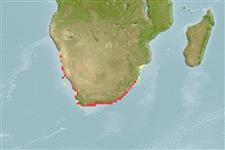>
Eupercaria/misc (Various families in series Eupercaria) >
Sparidae (Porgies)
Etymology: Chrysoblephus: Greek, chrysos = golden + Greek, blepo, blepharizo = to watch (Ref. 45335).
More on author: Valenciennes.
Environment: milieu / climate zone / depth range / distribution range
पारिस्थितिकी
समुद्री ड़िमरसल; गैर प्रवासी; गहराई सीमा 20 - 50 m (Ref. 28016). Subtropical; 22°S - 35°S
Southeast Atlantic: known only from the Cape to Natal in South Africa.
Length at first maturity / आकार / वज़न / Age
Maturity: Lm 30.0 range ? - ? cm
Max length : 75.0 cm TL पुल्लिंग / अलिंग; (Ref. 3198); common length : 50.0 cm TL पुल्लिंग / अलिंग; (Ref. 3507); अधिकतम प्रकाशित वज़न: 5.8 kg (Ref. 40637)
पृष्ठीय रीढ़ (सम्पूर्ण): 11 - 12; पृष्ठीय सौफट रेज़ (सम्पूर्ण): 10-11; गुदा कांटा 3; ऐनल सौफट रेज़: 7 - 9. Occasionally with darker crossbars. Adults males with a big hump on forehead.
Inhabits shallow coastal waters. Feeds on crustaceans, mollusks, worms and small fishes (Ref. 5213). Good food fish. Sold fresh in markets. It is parasitised by the monogenean Anoplodiscus cirrusspiralis on the fins and body surface (Ref. 124057).
Smith, J.L.B. and M.M. Smith, 1986. Sparidae. p. 580-594. In M.M. Smith and P.C. Heemstra (eds.) Smiths' sea fishes. Springer-Verlag, Berlin. (Ref. 3198)
IUCN Red List Status (Ref. 130435)
Threat to humans
Harmless
Human uses
मात्स्यिकी: व्यापारिक
अधिक जानकारी
संदर्भजलीयकृषिजलीयकृषि रूपरेखाखींचआनुवंशिकीElectrophoresesहैरेटिबिलटीबीमारीप्रक्रमणNutrientsMass conversion
सहयोगीयोतस्वीरेStamps, Coins Misc.ध्वनिसिगुयटिरारफ्तारतैरने के प्रकारगिल क्षेत्रOtolithsदिमागदृष्टि
साधन
Special reports
Download XML
इंटरनेट स्रोत
Estimates based on models
Preferred temperature (Ref.
123201): 15.1 - 24.9, mean 23.7 °C (based on 11 cells).
Phylogenetic diversity index (Ref.
82804): PD
50 = 0.5156 [Uniqueness, from 0.5 = low to 2.0 = high].
Bayesian length-weight: a=0.02692 (0.01424 - 0.05086), b=3.00 (2.84 - 3.16), in cm total length, based on LWR estimates for this species & Genus-body shape (Ref.
93245).
Trophic level (Ref.
69278): 3.7 ±0.54 se; based on food items.
लौटाव (Ref.
120179): निम्न, न्यूनतम जनसंख्या दुगनी होने का समय 4.5 - 14 वर्ष। (Preliminary K or Fecundity.).
Fishing Vulnerability (Ref.
59153): Moderate to high vulnerability (50 of 100).
